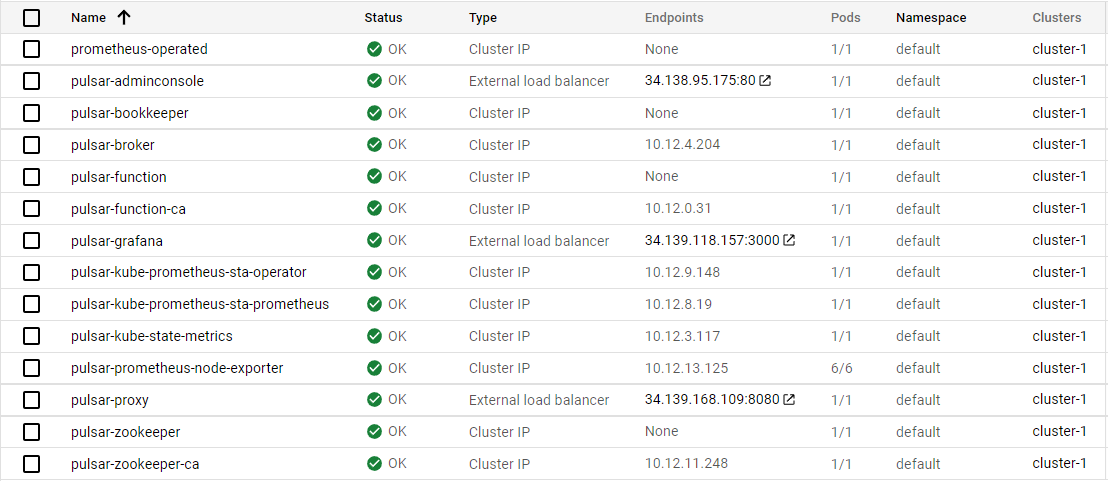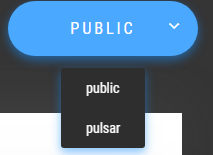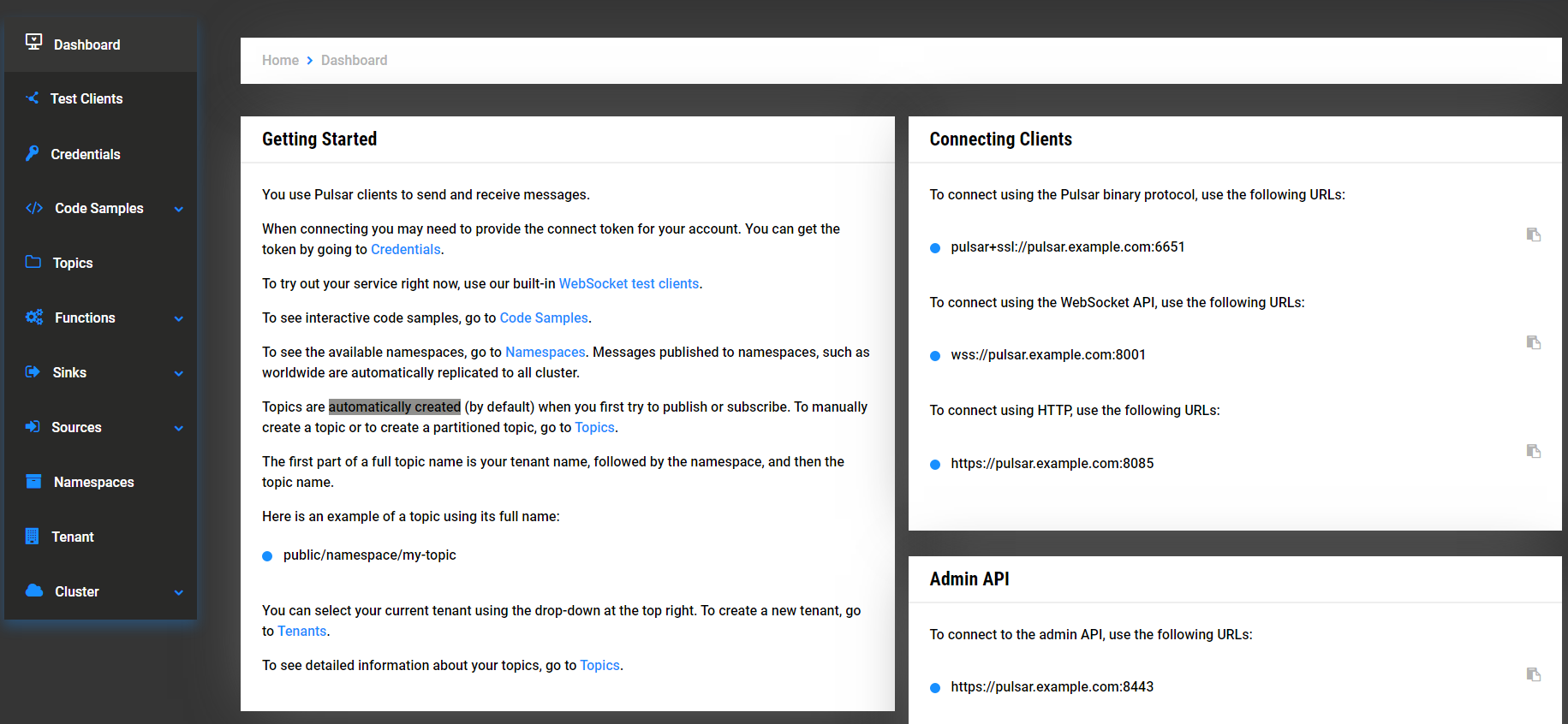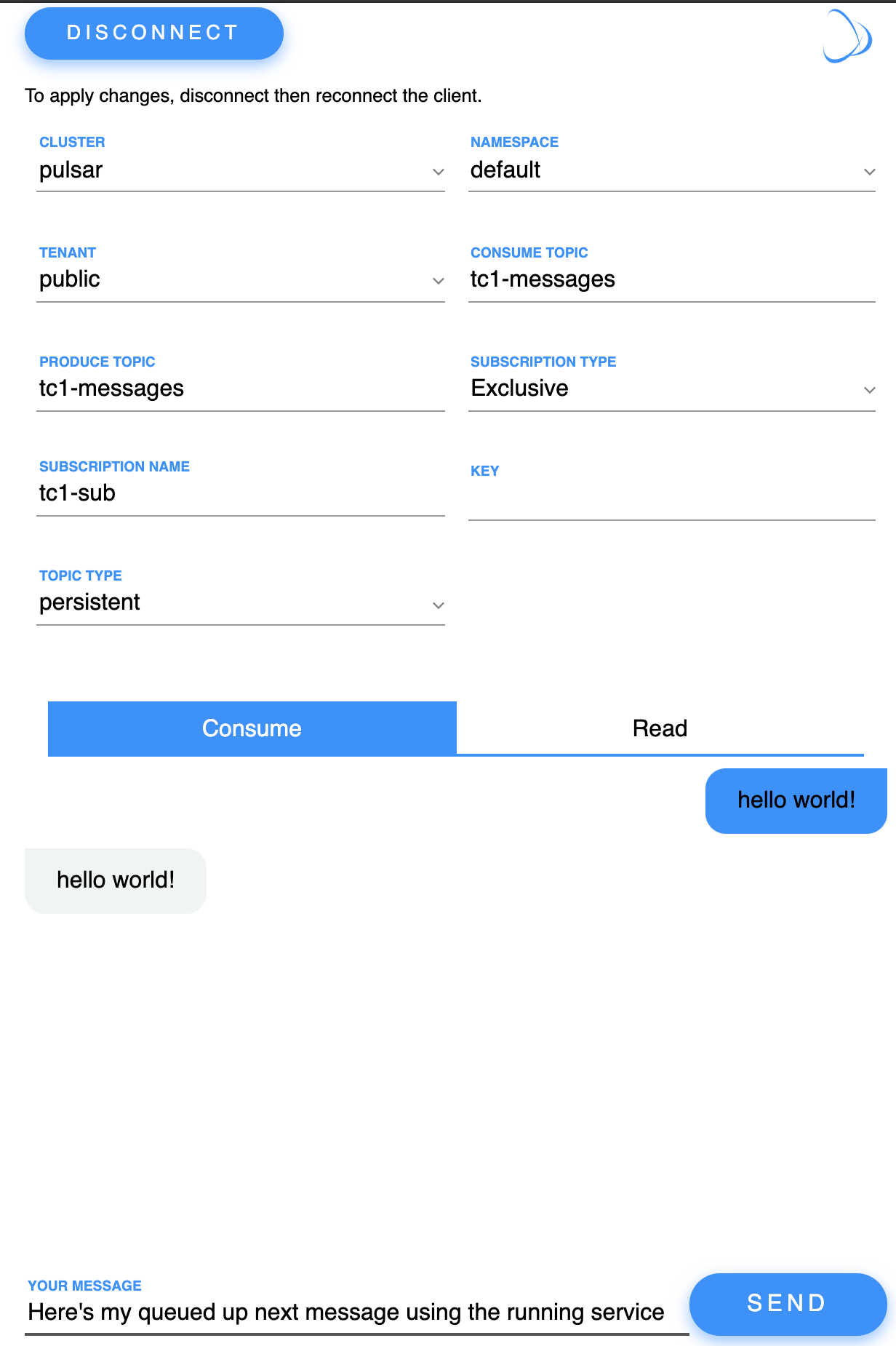Pulsar Admin Console
The DataStax Admin Console for Apache Pulsar® is a web-based UI from DataStax that administers topics, namespaces, sources, sinks, and various aspects of Apache Pulsar features.
Getting Started in Pulsar Admin Console
In the Luna Streaming Pulsar Admin Console, you can use Pulsar clients to send and receive pub/sub messages.
If you installed the Admin console with the DataStax Helm chart, access the Admin console via the pulsar-adminconsole external load balancer endpoint in your cloud provider:

Log in with username admin.
If you’re running a server or VM deployment, see Admin Console on Server/VM for instructions on deploying and accessing the Admin console.
Pulsar Admin Console features
To try out your service, use the built-in WebSocket test clients on the Pulsar Admin Console’s Test Clients page.
To see currently available namespaces, go to Namespaces, or select the button in the upper right corner.

Messages published to namespaces are automatically replicated to all node(s) in the cluster.

For interactive code samples, go to Code Samples.
Sending and receiving Pulsar messages
Go to the Pulsar Admin Console’s Test Clients page. The quickest way to try your service is to use the test clients and send messages from one client to the other.
In the WebSocket Test Client 1 section, click Connect. This action creates a connection from the Pulsar Admin Console that’s running in your browser to the Pulsar instance on your server.
Scroll down to the Consume tab. In this simple example, which verifies that the service is running properly, add a hello world message and click Send.
For example:

In doing so, you published a message to your server, and in the Test Client you’re listening to your own topic.
Your client is working with the Pulsar server.
Create new topics and tenants
By default, topics are automatically created when you first publish or subscribe. To manually create a topic or to create a partitioned topic, go to Topics.
The first part of a full topic name is your tenant name, followed by the namespace, and then the topic name.
For example, public/namespace/my-topic.
Select your current tenant using the menu at the top right of the Topics page.
To create a new tenant, go to Tenants.
To see detailed information about your topics, go to Topics.
Code samples
On the Pulsar Admin Console’s Code Samples page, there are examples for Java, Python, Golang, Node.js, WebSocket, and HTTP clients.
Each example shows Producer, Consumer, and Reader code, plus language-specific examples of setting project properties and dependencies.
For example, selecting Java will show you how to connect your Java project to Pulsar by modifying your Maven’s pom.xml file.
Connecting to Pulsar
This section describes how to connect Pulsar components to the Admin console.
Creating and showing credentials
When connecting clients, you’ll need to provide your connect token to identify your account. In the Pulsar APIs, you specify the token when creating the client object. The token is your password to your account, so keep it safe.
The code samples automatically add your client token as part of the source code for convenience. However, a more secure practice would be to read the token from an environment variable or a file.
In the Admin console’s Credentials page, select Create New token and follow the instructions.
If you previously created a token, use the Credentials page to get its value.
Connecting Clients
To connect using the Pulsar binary protocol, use the following URL format with port 6651:
pulsar+ssl://<dns-name>:6651
For example, for an installed node with a DNS name ip-10-101-32-250.srv101.dsinternal.org:
pulsar+ssl://ip-10-101-32-250.srv101.dsinternal.org:6651
Connect with WebSocket API
To connect using the WebSocket API, use the following URL format with port 8001:
wss://<dns-name>:8001
For example:
wss://ip-10-101-32-250.srv101.dsinternal.org:8001
Connect to Pulsar admin API
To connect to the admin API, use the following URL format with port 8443:
For example, give a DNS name of ip-10-101-32-250.srv101.dsinternal.org:
You can list all the tenants like this, for example:
pulsar-admin --admin-url https://ip-10-101-32-250.srv101.dsinternal.org:8443
Or if you have authentication enabled, like this:
pulsar-admin --admin-url https://ip-10-101-32-250.srv101.dsinternal.org:8443 \
--auth-plugin org.apache.pulsar.client.impl.auth.AuthenticationToken \
--auth-params file:///token.jwtYou can get the token from the Pulsar Admin Console’s Credentials page.
Alternatively, you can save the URL authentication parameters in your client.conf file.
Admin console video
You can also follow along with this video from our Five Minutes About Pulsar series to get started with the admin console.
Next steps
For more on building and running a standalone Pulsar Admin console, see the Admin Console on Server/VM or the Pulsar Admin console README.
